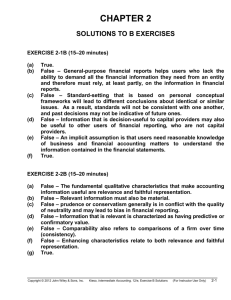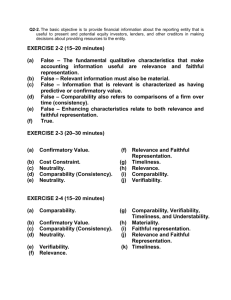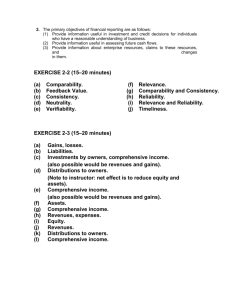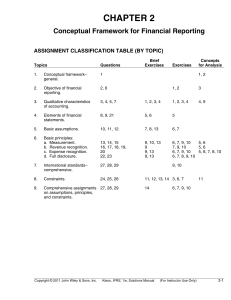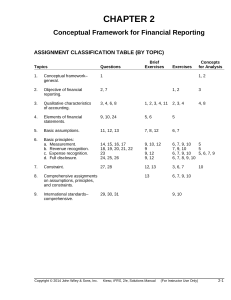solutions to b exercises
advertisement
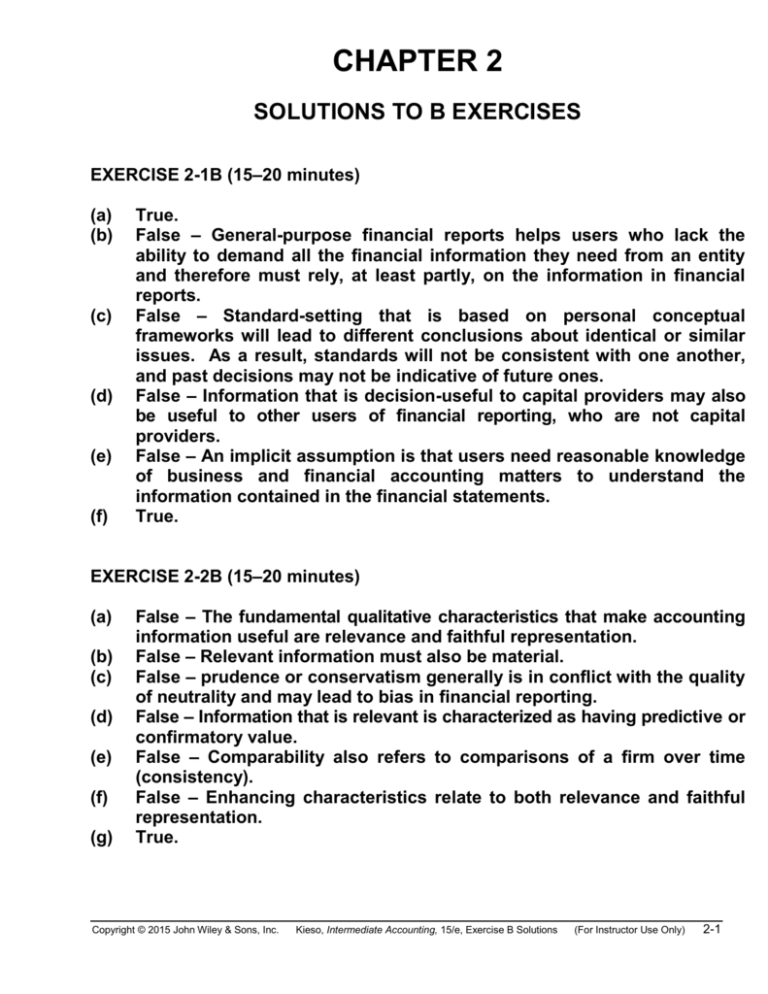
CHAPTER 2 SOLUTIONS TO B EXERCISES EXERCISE 2-1B (15–20 minutes) (a) (b) (c) (d) (e) (f) True. False – General-purpose financial reports helps users who lack the ability to demand all the financial information they need from an entity and therefore must rely, at least partly, on the information in financial reports. False – Standard-setting that is based on personal conceptual frameworks will lead to different conclusions about identical or similar issues. As a result, standards will not be consistent with one another, and past decisions may not be indicative of future ones. False – Information that is decision-useful to capital providers may also be useful to other users of financial reporting, who are not capital providers. False – An implicit assumption is that users need reasonable knowledge of business and financial accounting matters to understand the information contained in the financial statements. True. EXERCISE 2-2B (15–20 minutes) (a) (b) (c) (d) (e) (f) (g) False – The fundamental qualitative characteristics that make accounting information useful are relevance and faithful representation. False – Relevant information must also be material. False – prudence or conservatism generally is in conflict with the quality of neutrality and may lead to bias in financial reporting. False – Information that is relevant is characterized as having predictive or confirmatory value. False – Comparability also refers to comparisons of a firm over time (consistency). False – Enhancing characteristics relate to both relevance and faithful representation. True. Copyright © 2015 John Wiley & Sons, Inc. Kieso, Intermediate Accounting, 15/e, Exercise B Solutions (For Instructor Use Only) 2-1 E2-3B (20–30 minutes) (a) (b) (c) (d) (e) Relevance. Comparability Consistency. Confirmatory value. Relevance and faithful representation. Neutrality. (f) (g) (h) (i) Cost constraint. Neutrality. Timeliness. Verifiability. (j) Comparability. Confirmatory value. Verifiability. Comparability, verifiability, timeliness, and understandability. Timeliness. Relevance and faithful representation. E2-4B (15–20 minutes) (a) (b) (c) Faithful representation. Neutrality. Comparability. (f) (g) (h) (d) (e) Relevance. Comparability. (i) (j) E2-5B (15–20 minutes) (a) Revenues, expenses. (b) Distribution to owners (Note: Net effect is to reduce equity and assets). (c) Gains, losses. (d) Assets. (e) Investment by owners, comprehensive income (or, revenues and gains). (f) Liabilities. (g) Comprehensive income (also possible would be revenues and gains). (h) Comprehensive income. (i) Revenues. (j) Equity. (k) Comprehensive income. (l) Distributions to owners. 2-2 Copyright © 2015 John Wiley & Sons, Inc. Kieso, Intermediate Accounting, 15/e, Exercise B Solutions (For Instructor Use Only) E2-6B (15–20 minutes) (a) (b) (c) (d) (e) (f) (g) (h) 5. 2. 7. 1. 8. 5. 4. 3. Measurement principle (fair value). Going concern assumption. Expense recognition principle. Economic entity assumption. Full disclosure principle. Measurement principle (historical cost ). Periodicity assumption. Monetary unit assumption. E2-7B (20–25 minutes) (a) (b) (c) (d) (e) (f) (g) (h) (i) (j) (k) (l) (m) (n) (o) (p) (q) Full disclosure principle. Expense recognition principle. Measurement principle (historical cost ). Measurement principle (fair value). Full disclosure principle. Measurement principle (fair value). Materiality. Economic entity assumption. Full disclosure principle. Revenue recognition principle. Expense recognition principle. Measurement (fair value) principle. Periodicity assumption. Measurement principle (historical cost). Economic entity assumption. Materiality. Expense recognition and revenue recognition principles. Copyright © 2015 John Wiley & Sons, Inc. Kieso, Intermediate Accounting, 15/e, Exercise B Solutions (For Instructor Use Only) 2-3 E2-8B (20 minutes) (a) This event need not be disclosed in the financial statements. The amount of monies involved is relatively small in relation to the net income of the business and should not affect the fairness of the presentation of the financial statements. (b) According to GAAP, the basis upon which inventory amounts are stated (lower of cost or market) and the method used in determining cost (LIFO, FIFO, average cost, etc.) should also be reported. The disclosure requirement related to the method used in determining cost should be emphasized, indicating that where possible alternatives exist in financial reporting, disclosure in some format is required. (c) Comparability requires that disclosure of changes in accounting principles be made in the financial statements. To do otherwise would result in financial statements that are misleading. Financial statements are more useful if they can be compared with similar reports for prior years. (d) The proper accounting for this situation is to report the equipment as an asset and the notes payable as a liability on the balance sheet. Offsetting is permitted in only limited situations where certain assets are contractually committed to pay off liabilities. (e) It is well established in accounting that revenues and cost of goods sold must be disclosed in the reporting of an income statement. It might be noted to students that such was not always the case. At one time, only net income was reported but over time we have evolved to the present reporting format. 2-4 Copyright © 2015 John Wiley & Sons, Inc. Kieso, Intermediate Accounting, 15/e, Exercise B Solutions (For Instructor Use Only) E2-9B (15–20 minutes) (a) Probably the company is too conservative in its accounting for this transaction. The expense recognition principle indicates that expenses should be allocated to the appropriate periods involved. In this case, there appears to be a high uncertainty that the company will have to pay. FASB ASC 450-20-25 requires that a loss should be accrued only (1) when it is probable that the company would lose the suit and (2) the amount of the loss can be reasonably estimated. (Note to instructor: The student will probably be unfamiliar with FASB ASC 450-20-25. The purpose of this question is to develop some decision framework when the probability of a future event must be assumed.) (b) At the present time, accountants do not recognize price-level adjustments in the accounts. Hence, it is misleading to deviate from the measurement principle (historical cost) because conjecture or opinion can take place. It should also be noted that depreciation is not so much a matter of valuation as it is a means of cost allocation. Assets are not depreciated on the basis of a decline in their fair market value, but are depreciated on the basis of systematic charges of expired costs against revenues. (Note to instructor: It might be called to the students’ attention that the FASB does encourage supplemental disclosure of price-level information.) (c) Most accounting methods are based on the assumption that the business enterprise will have a long life. Acceptance of this assumption provides credibility to the historical cost principle, which would be of limited usefulness if liquidation were assumed. Only if we assume some permanence to the enterprise, is the use of depreciation and amortization policies justifiable and appropriate. Therefore, it is incorrect to assume liquidation as Barela, Inc. has done in this situation. It should be noted that only where liquidation appears imminent is the going concern assumption inapplicable. (d) The measurement principle (historical cost) indicates that assets and liabilities are accounted for on the basis of cost. If we were to select sales value, for example, we would have an extremely difficult time in attempting to establish a sales value for a given item without selling it. It should further be noted that the revenue recognition principle provides the answer to when revenue should be recognized. Revenue should be recognized when the company satisfies a performance obligation. Copyright © 2015 John Wiley & Sons, Inc. Kieso, Intermediate Accounting, 15/e, Exercise B Solutions (For Instructor Use Only) 2-5 E2-9B (Continued) (e) This entry violates the economic entity assumption. This assumption in accounting indicates that economic activity can be identified with a particular unit of accountability. In this situation, the company erred by charging this cost to the wrong economic entity. (f) The answer to this question is the same as (d). 2-6 Copyright © 2015 John Wiley & Sons, Inc. Kieso, Intermediate Accounting, 15/e, Exercise B Solutions (For Instructor Use Only) E2-10B (15–20 minutes) (a) Assets should be recorded at the fair market value of what is given up or the fair market value of what is received, whichever is more clearly evident. It should be emphasized that it is not a violation of the historical cost principle to use the fair market value of the stock. Recording the asset at the par value of the stock has no conceptual validity. Par value is merely an arbitrary amount usually set at the date of incorporation. (b) The gain should be recognized at the point of sale. Deferral of the gain should not be permitted, as the company has satisfied its performance obligation. To explore this question at greater length, one might ask what justification other than the controller’s might be used to justify the deferral of the gain. For example, the rationale provided in GAAP, noncompletion of the earnings process, might be discussed. (c) It appears from the information that the sale should be recorded in 2015 instead of 2014. Regardless of whether the terms are f.o.b. shipping point or f.o.b. destination, the point is that the inventory was sold in 2015. It should be noted that if the company is employing a perpetual inventory system in dollars and quantities, a debit to Cost of Goods Sold and a credit to Inventory is also necessary in 2015. (d) A gain should not be recognized until the inventory is sold. Accountants follow the measurement principle (historical cost) and write-ups of assets are not permitted. It should also be noted that the revenue recognition principle states that revenue should not be recognized until the performance obligation is satisfied. (e) Depreciation is an allocation of cost, not an attempt to value assets. As a consequence, even if the value of the building is increasing, costs related to this building should be matched with revenues on the income statement, not as a charge against retained earnings. Copyright © 2015 John Wiley & Sons, Inc. Kieso, Intermediate Accounting, 15/e, Exercise B Solutions (For Instructor Use Only) 2-7
